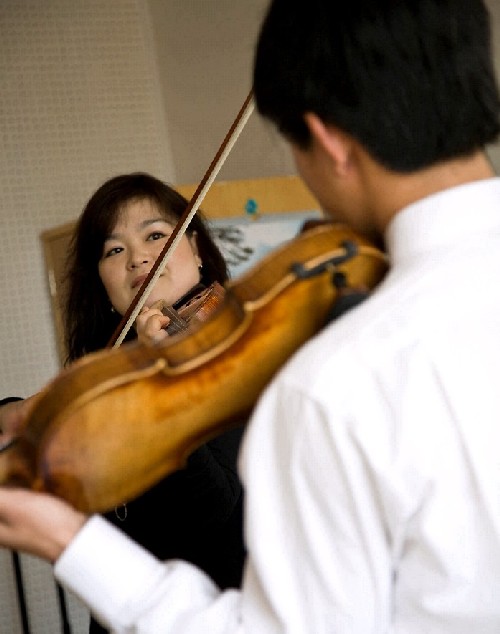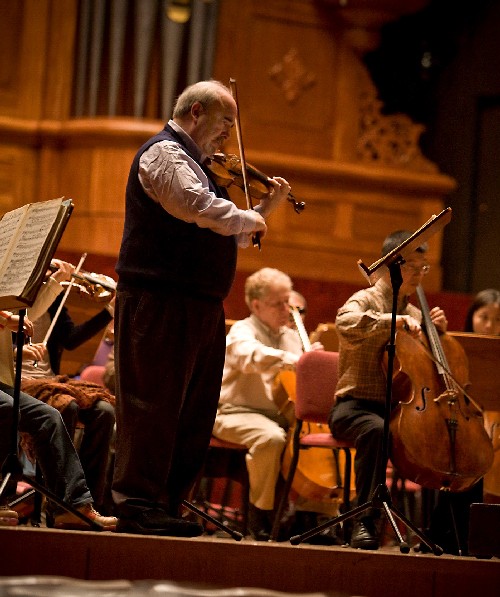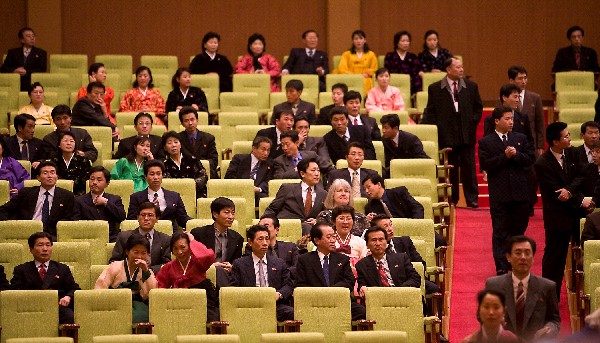Allegro
A Musical Meeting of East and West
Touring North Korea
Volume CVIII, No. 5May, 2008
 Michelle Kim, assistant concertmaster with the New York Philharmonic, works with a young student at the Pyongyang Conservatory of Music. All photos by David Finlayson. |
As the New York Philharmonic’s recent tour to Asia approached, there was considerable nervous anticipation within the orchestra. Some were concerned about safety, some about personal comfort, but much of the discussion centered on whether we should be going to North Korea at all and whether our performing there would merely be playing into the hands of the dictatorship.
Somewhat lost in the news coverage of the event was the fact that this was originally a tour of Taiwan and China to which the concerts in North Korea and Seoul had been recently added.
It was instructive to visit China first and see the enormous changes that were taking place, 35 years after the Philadelphia Orchestra’s landmark tour of that country. One current member of the New York Philharmonic was on that 1973 tour while another was a young music student in the audience. Both felt that the Philadelphia tour had a significant impact. After the recent crackdown in Tibet it is tempting to conclude that little has changed there, but certainly the average Chinese citizen has far more personal choice now than he did then.
Our first big surprise, boarding the plane in Beijing, was to suddenly find ourselves accompanied by 80 journalists. The plane was barely off the ground before they were roaming the aisles, filming, photographing and conducting interviews. The coverage produced by these journalists, both during and after the trip, conveyed considerable hope. There was a great deal of wistful commentary on how moved the audience was, how long they clapped, and how they waved to us at the end.
 Concertmaster Glenn Dicterow rehearses with the New York Philharmonic during the Asian tour. |
Were they so moved? How do we know that? Long, sustained applause at the end of a concert was standard fare throughout Asia, and seemed to connote respect rather than fervor. The children at the performance the next day waved to us at the end of their performance, possibly suggesting that this, too, is common in their country. We all hope that they noticed the diversity within our orchestra, and that they noted and appreciated the energy and openness of the physical and facial gestures which are clearly different from their own performance norms.
In North Korea we were struck by stark contrasts: the elegant, marbled performance spaces and the dreary, Stalinesque apartment buildings; the dynamic performances of the children on stage and the frighteningly impassive faces of the children in the audience; the reputation for extreme repression and the freedom to photograph almost anything. Leaving the hotel’s revolving restaurant after lunch one day I attempted to walk down the 12 flights to my room. Within two flights, boxes on the stairs and angry North Koreans blocked my way and it appeared that people were living in those spaces. One reporter commented that “the veneer of normalcy is quite thin here.”
One member of the orchestra was asked by their minder, “Do Americans really believe that we support terrorism?” This question, combined with the overheated rooms, the lavish banquets, the generous speeches and the flawless performances make it clear that their goal was to impress, to humanize themselves as a people, and to distance themselves from the “Axis of Evil” label put on them by our government.
 The North Korean audience gathers. |
The North Koreans we talked to are justifiably proud of the performers that we saw, the professional musicians and dancers on the night we arrived, and the children from the “Children’s Palace of Culture” on the morning we left. The performances were elegant, thoroughly professional, well rehearsed and brilliantly executed. One couldn’t help but notice, however, that the dances were all rather similar. I feel that the music and the choreography lack sophistication. The North Koreans are also proud of the “purity” of their culture, unmarred by the pernicious influences of the West and of the Internet. I can see that they have repeated and refined these dances to a point where they approach a kind of ingrown perfection.
In reading the extensive press coverage of our trip it seemed that everyone was intent on breaking through the barrier of their reserve and isolation and making sure that we reached them in some meaningful and personal way. Perhaps we did, but it is far from certain, and it will be a very long time before we will have any first-hand accounts of the impact that has been made. If, however, through an ongoing series of cultural exchanges, we were to continue to view them as a proud and cultured people, and if more North Koreans came to view us as less aggressive than their official propaganda might have them believe, who knows what might eventually be possible?
